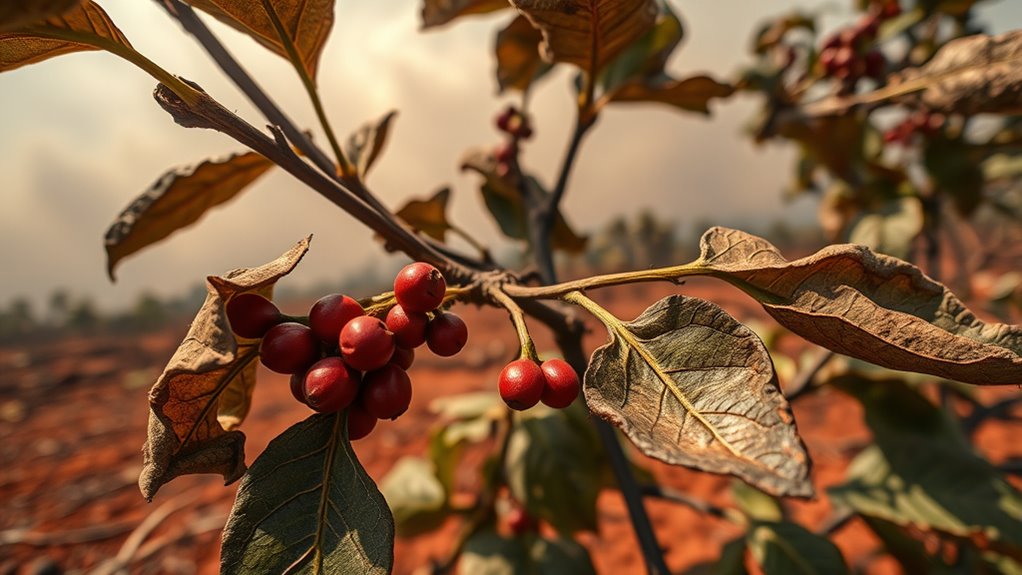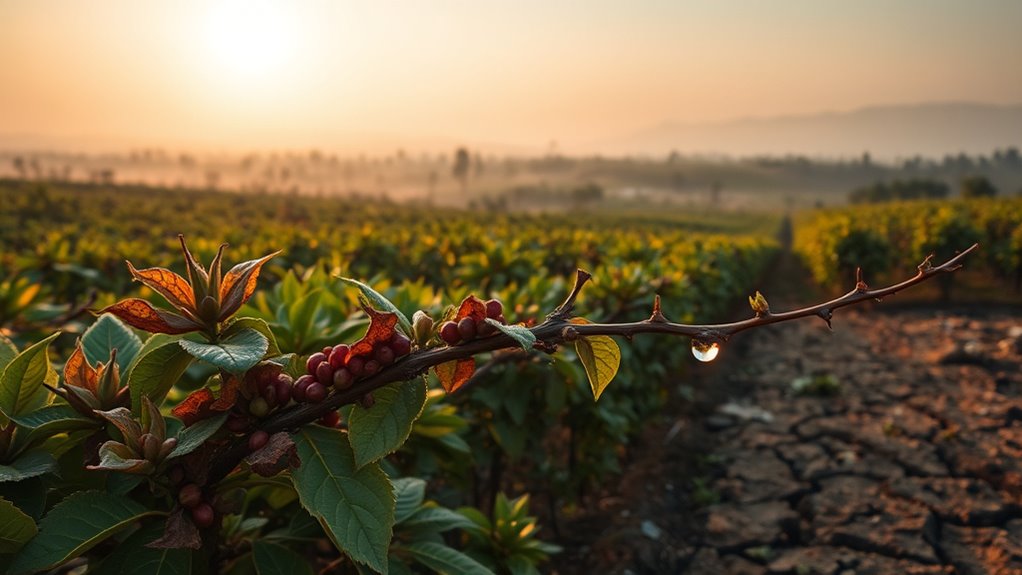Climate change is seriously affecting coffee production by shrinking suitable land, spreading pests and diseases, and disrupting harvest schedules. Rising temperatures can make traditional growing areas less viable, while unpredictable weather and extreme events damage crops and infrastructure. Farmers face increased costs and challenges to keep up with changing conditions. If you want to discover how these changes might impact your coffee and what can be done, there’s more to explore below.
Key Takeaways
- Rising temperatures reduce suitable land for coffee cultivation worldwide.
- Climate change promotes the spread of pests and diseases like coffee leaf rust.
- Altered flowering and harvesting cycles disrupt traditional coffee production schedules.
- Extreme weather events damage crops and infrastructure, impacting supply chains.
- Developing climate-resilient coffee varieties and sustainable practices is essential for future viability.

Climate change is considerably affecting coffee production worldwide, threatening the very regions where coffee has traditionally been grown. As global warming accelerates, rising temperatures and changing weather patterns are shrinking the land suitable for cultivating coffee. You might notice that areas once ideal for coffee are becoming less productive or completely unsuitable, especially in traditional producers like Brazil.
This reduction in essential land directly impacts the global supply, making coffee harder to grow and more expensive to produce.
The impact of climate change extends beyond land availability. Increased temperature rise and unpredictable weather patterns promote the spread of pests and diseases, such as coffee leaf rust. This fungus thrives in warmer, wetter conditions, causing significant crop losses and threatening the livelihoods of farmers.
To combat these threats, farmers are adopting new agricultural practices aimed at building climate resilience. These include diversifying coffee varieties that are more resistant to pests and disease, as well as adjusting planting schedules to better align with shifting climatic conditions. These adaptive steps are indispensable to maintaining coffee production amid the changing climate.
Phenological shifts are also disrupting traditional harvest cycles. You might find that coffee plants are flowering earlier or maturing faster, which complicates harvesting schedules and impacts yield stability. These changes in growth patterns are a direct result of temperature rise and altered weather patterns, making it more difficult for farmers to predict essential harvest times and maintain consistent quality.
Moreover, extreme weather events such as droughts, floods, and landslides are increasing in frequency and intensity, damaging crops and infrastructure alike. These natural disasters hinder not only the growth of coffee but also the transportation and processing systems essential for bringing coffee to market.
Developing climate-resilient coffee varieties is crucial for ensuring future production stability. Breeding programs focus on creating plants that can withstand higher temperatures, irregular rainfall, and pests.
Additionally, farmers are adopting more sustainable agricultural practices to adapt to the new realities of climate change. The combined effort of better agricultural practices and innovative coffee varieties aims to mitigate the adverse effects of climate change on coffee production.
Ultimately, understanding the impact of climate change on coffee emphasizes the need for urgent action. The ongoing temperature rise and shifting weather patterns threaten the stability of coffee supply chains and the livelihoods of millions of farmers worldwide.
Embracing resilience strategies and sustainable practices will be essential for safeguarding coffee’s future amid these unprecedented environmental changes.
Frequently Asked Questions
How Is Coffee Being Affected by Climate Change?
You see that coffee faces serious threats from climate change. Rising temperatures, unpredictable rainfall, and droughts stress plants, reducing yields and quality.
Pests and diseases spread faster, causing more damage. Extreme weather like floods and droughts destroy crops and infrastructure.
Changes in flowering and maturation times disrupt harvests. Overall, climate change makes it harder for you to enjoy consistent, high-quality coffee, impacting farmers and consumers alike.
How Does Weather Affect Coffee?
Weather directly impacts your coffee by influencing its growth stages, from flowering to ripening. When temperatures rise, your coffee plants might flower earlier and mature faster, but stress can lower yields.
Unpredictable rain can harm plants, cause pests, or delay harvests. Extreme events like frost or floods can wipe out crops or disrupt schedules.
Consistent, moderate weather guarantees better quality, flavor, and crop stability.
What Are the Environmental Issues With Coffee Production?
You should know that coffee production faces serious environmental issues. Rising temperatures and unpredictable rainfall shrink suitable land, making it harder to grow coffee.
Pests and diseases thrive in warmer, humid conditions, damaging crops. Extreme weather like droughts and floods disrupt farms, cause soil erosion, and degrade land.
This not only harms the environment but also threatens the livelihoods of farmers and the future of coffee cultivation.
Is Climate Change Putting the Future of the Entire Coffee Sector at Risk?
Yes, climate change threatens the future of the coffee sector. Rising temperatures and unpredictable weather reduce suitable land and increase pests and diseases, causing massive crop losses.
Major producers face declining yields, risking economic hardship for farmers and industry stability. Without adaptive measures, the global coffee supply could drop sharply by mid-century, potentially leading to the sector’s collapse.
It’s vital you support sustainable practices and innovations to safeguard coffee’s future.
Does Climate Change Mean a Future Without Coffee?
You might wonder if climate change means a future without coffee. The reality is, it’s a real threat. Rising temperatures, unpredictable weather, and pests could drastically cut down suitable growing areas, making it harder for farmers to produce coffee.
Developing new resilient varieties takes time, so immediate action is essential. If we don’t adapt and intervene now, the global coffee supply could shrink considerably, impacting everyone who loves coffee.
Conclusion
As you can see, climate change is critically threatening coffee production. Rising temperatures, unpredictable weather, and pests make it harder for coffee to thrive. If you care about your morning brew, it’s essential to support sustainable practices and advocate for policies that protect these indispensable ecosystems. By taking action now, you can help guarantee future generations still enjoy that perfect cup of coffee. Your choices truly make a difference in combating climate change’s impact on coffee.









